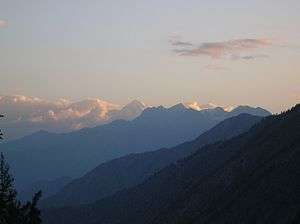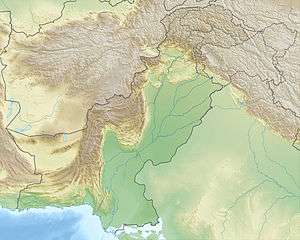Haramosh Peak
Haramosh Peak (Urdu: ہراموش چوٹی; also known as Haramosh or Peak 58) is a mountain located in the Karakoram range of the Gilgit-Baltistan of Pakistan. Its height is also often given as 7,409m. Haramosh lies about 65 kilometres (40 mi) east of Gilgit, in the south-central region of the Rakaposhi-Haramosh Mountains, a subrange of the Karakoram range. It rises steeply above the north bank of the Indus River, a little ways upstream of its confluence with the Gilgit River. The massif has two summits, Haramosh Peak and Haramosh Kutwal Laila Peak. The peak was first scaled in 1958 by an Austrian team consisting of Heini Roiss, Stephan Pauer, and Dr. Franz Mandl.[3]
| Haramosh Peak ہراموش چوٹی | |
|---|---|
 Haramosh in 2008 | |
| Highest point | |
| Elevation | 7,397 m (24,268 ft) [1][2] Ranked 67th |
| Prominence | 2,277 m (7,470 ft) [1] |
| Listing | Ultra |
| Coordinates | 35°50′24″N 74°53′51″E [1] |
| Geography | |
 Haramosh Peak ہراموش چوٹی Location in Pakistan | |
| Location | Gilgit–Baltistan, Pakistan |
| Parent range | Rakaposhi-Haramosh Mountains, Karakoram |
| Climbing | |
| First ascent | 1958 by an Austrian team |
| Easiest route | rock/snow/ice climb |
Climbing history
Haramosh was first reconnoitered in 1947 by a Swiss team, and a German team investigated a northeastern route in 1955. In 1957, Tony Streather, John Emery, Bernard Jillot and Rae Culbert, a team from Oxford University experienced repeated falls and misfortunes during a failed attempt, leading to the deaths of Jillot and Culbert. Streather and Emery survived. The latter suffered severe frostbite and lost all of his fingers and toes. The epic tale of this expedition is told in Ralph Barker's The Last Blue Mountain.
Haramosh was first climbed on 4 August 1958 by three Austrian mountaineers, Heinrich Roiss, Stefan Pauer and Franz Mandl, via the Haramosh La (a saddle to the northeast) and the East Ridge, roughly the route of the 1957 tragedy.[4]
According to the Himalayan Index,[5] there have been only three more ascents, in 1978 (Japanese, West Ridge), 1979 (unknown party/route), and 1988 (Polish, Southwest Face).
References
- "Karakoram ultra-prominences". peaklist.org. Retrieved 2014-01-11.
- "Haramosh, Pakistan". Peakbagger.com. Retrieved 1 December 2019.
- Babar, Samar (2010). The Epic of Haramosh. The Army Press.
- "Haramosh Peak". Peakware.com. Archived from the original on 2016-03-04. Retrieved 1 December 2019.
- "Himalayan Index". The Alpine Club. Retrieved 2014-01-11.
Sources
- Neate, Jill (1990). High Asia: An Illustrated History of the 7000 Metre Peaks. Mountaineers Books. ISBN 0898862388.
- Barker, Ralph (2006). The Last Blue Mountain. Ripping Yarns.com. ISBN 1-904466-30-3.
- Wala, Jerzy (1990). "Orographical Sketch Map of the Karakoram". Swiss Foundation for Alpine Research. Archived from the original on 2008-02-23.
External links
- Picture of the Haramosh south face
- A world peak list ranked by local relief and steepness (Reduced Spire Measure) features Haramosh as the world #17.